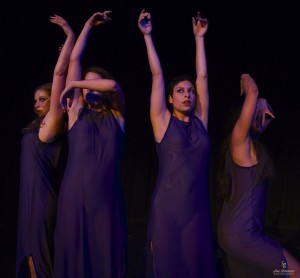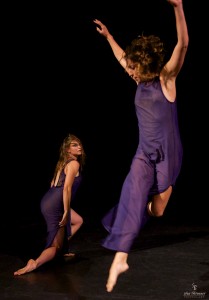Lascivious Vampires and Artistic Choices
Hirudinea is the taxonomic term for leeches, and “Hirudinea and Her Host” of everything I saw at the San Diego International Fringe Festival, is the work that most fastened itself in me. The 20- to 25-minute piece, by Zaquia Mahler Salinas, features lush choreography and knockout dancing by a four-woman cast. And it left me with big questions about Salinas’s artistic choices.
In her program notes, Salinas says the piece “explores the different ways we give to and take from each other in order to fulfill our needs” and that “we can suck one another dry.” Sucking, as in one woman taking another’s hand in her mouth, happens here. So does feverish eroticism, the women pairing off in charged embraces and combative clinches. One woman forces another onto all-fours and “rides” her. And there’s a moment when a woman is vampirically poised over another’s neck.
The dancers—Salinas, Desiree Cuizon, Angelica Lee Bell, and Sarah Navarrete—are young and gorgeous. And their costumes (by Elva Salinas), semi-sheer sheaths over flesh-colored maillots, sometimes give the impression of near-nude breasts.
All of which made “Hirudinea and Her Host” feel like it belonged in an artsy gentleman’s club. (In her review, my colleague Kris Eitland compared it to female mud wrestling.) Maybe that’s what Salinas was going for. But I think she shortchanged herself and her superb cast.
Her starting-place of exploring leech-like relationships is potentially rich, a gateway to dark, complex territory. As a dance artist, she needed to physicalize that exploration, and it’s no surprise that she went first to images embedded in popular culture—the dominatrix, the vampire. The problem is that she stayed with those clichéd, commercial images, rather than going more deeply and showing us something new.
Then there’s the nature of the images, in which attractive young women are exclusively sexualized. I applaud the risks Salinas took by playing with eroticism, and perhaps her intention was to critique clichéd ways of representing the female body. But that idea occurred to me only after hours of thinking and writing about this piece. If Salinas did set out to subvert conventions by presenting them, there was too much convention and not enough subversion.
I see arts criticism as part of a conversation involving the artist, the work, and the audience, in which the critic can expand and deepen the discussion by articulating themes, offering context, and, in a sense, posing the kind of reading group questions you find at the back of novel. Engaged discussion is particularly called for when an artist of Salinas’s gifts creates work as challenging as “Hirudinea and Her Host.” It’s in that spirit that I’m sharing the issues the piece raised for me.
“Hirudinea and Her Host” is part of the show “Perception and Perseverance” at the Spreckels Theatre (along with a piece by Blythe Barton, which I’ll review in another article) and plays one more time, Sunday at 5:00. I hope you’ll add your comments to the conversation.

Award-winning dance journalist Janice Steinberg has published more than 400 articles in the San Diego Union-Tribune, Dance Magazine, the Los Angeles Times, and elsewhere. She was a 2004 New York Times-National Endowment for the Arts fellow at the Institute for Dance Criticism and has taught dance criticism at San Diego State University. She is also a novelist, author of The Tin Horse (Random House, 2013). For why she’s passionate about dance, see this article on her web site, The Tin Horse



Janice, thanks actually very much for this review/lesson. I think this kind of constructive positing is in fact extremely helpful for artists, myself included to figure out, know if we are prepared, have the time, resources to actually explore our idea to the extent in the ways you describe which many of us often intend. Having some familiarity with many younger artists work in town I don’t disagree there are times still when they believe they are exploring, presenting things in new ways and really not. Heck, some of us more practiced folks still make our share of misjudgments not easily covered by smoke & mirrors or in my case the “lack there of”. Direction and dramaturge after the fact is unfortunate and many of us will continue to benefit from authentic, honest, objective, challenging of our ideas, exploration, goals, identifying audience, purpose, process before and during. THAT’S ALOT!,..and extremely challenge prospects without ample time, space, funding. Still, if you take something on, you have to figure out how you plan to make it happen right? I have many more thoughts (as usual) on how to make that happen as well as about the purpose, and future potential of the SD Fringe Festival. Enjoy the rest and thanks very much for this wise, and helpful platform.
I would like to thank you, Janice, for sharing your opinion and perspective on this piece and opening up a conversation, as we rarely have the opportunity to discuss in this way. I feel that, rather than comment upon artistic choices, we should engage in a conversation about the paradigms through which we view the dancing female body. Though this work does not push any extremes of female sexuality nor comment upon them, I feel as though that is what stood out to you, and should be addressed. The feelings that this piece brought up for you raise some questions for me, as I am making for from the perspective of a young female artist in 2014:
What is it about “attractive young women” in sheer dresses, embodying the intensity and extremes of giving and taking that is only appropriate for a gentleman’s club? Why is the theater stage not the correct venue for a dance performance, regardless of the content?
What is so challenging about observing a woman confident and exposed, that the only way to make sense of dynamic power shifts and assertions developed through movement between women is to view it through lenses of fetichism and sex solicitation?
Again, this is not related to the movement or thematic content of my piece. Rather, it is a response to a perception of the work. Often times, perceptions and responses to art are the most exciting part of the process- to see where the audience takes it, what they derive, how they interpret.
I encourage anyone who is intrigued by this discourse (especially those who would like to contribute to it) to attend the show tomorrow, Sunday, at 5pm at Spreckels. Also, for your reference, Kris Eitland’s review of this work: http://www.sandiegostory.com/deadly-sins-seductive-dance-divorce-musical-fringe-fest-2014-invades-downtown/
Zaquia, I appreciate your very thoughtful response to my review. And thank you for creating work so powerful that I woke up the next morning feeling compelled to write about it.
So much about “Hirudinea” thrilled me: your movement vocabulary, which was simultaneously fluid yet fierce; the dancers’ assured performances; the tightness of the ensemble. And I was fascinated to learn that your poetic title was the scientific name for leeches.
I think it speaks to the power of this piece that, just as I found many elements enthralling, I found the imagery troubling, as I discussed in my review. Playing with images that have strong cultural associations can be a way to reframe those images. On the other hand, there’s the danger that, for the viewer, those pervasive cultural associations may overshadow the alternate frame you’re trying to present. That was my experience.
It’s not every day that I see work that pushes and challenges me as a critic. Thank you, Zaquia, for creating a piece that did that.